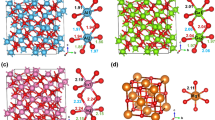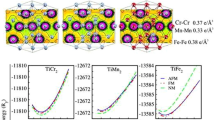Abstract
Many independent investigations have shown, that the ligand field stabilization energy LFSE has, in addition to other factors such as ionic size, site distortion, covalency, respectively, an important influence on the distribution of transition elements between different coexisting minerals as well as between different, crystallographic sites within the same mineral. A transition element prefers or is enriched in that mineral or that lattice position within a mineral, in which its LFSE has its maximum value. Principally, the LFSE of transition metal ions can be evaluated from the absorption spectra in the visible and near infrared parts of the electromagnetic spectrum. In the present paper, the influence of the LFSE on the polyhedral distortion, the phase stability, the intra-as well as the intercrystalline cation distribution of transition metal ions in some well established examples is presented and discussed. The Gibbs free energies of the exchange reactions can be evaluated from the site occupancies and used as a measure for the site preference. Deviations from a pure ionic model are explained on the basis of MO-theory and covalent bonding and other crystal chemical effects.
Similar content being viewed by others
References
Abs-Wurmbach I, Langer K, Seifert F, Tillmanns E (1981) The crystal chemistry of (Mn3+,Fe3+)-substituted andalusites (viridines and kanonaite), (Al1-x-yMn3+ xFe3+ y)2(O/SiO4): crystal structure refinements, Mössbauer, and polarized spectra. Z Krist 155:81–113
Abs-Wurmbach I, Langer K, Schreyer W (1983) The influence of Mn3+ on the stability relations of the Al2SiO5 polymorphs with special emphasis on manganian andalusites (viridines), (Al1-xMn3+ x)2(O/SiO4): An experimental investigation. J Petrol 24:48–75
Amthauer G (1976) Crystal chemistry and colour of chromium bearing garnets. N Jahrb Mineral Abh 126:158–186
Amthauer G, Günzler V, Hafner SS, Reinen D (1982) The distribution of Fe3+ and Ga3+ between octahedral and tetrahedral sites in garnets, Y3(Fe,Ga)5O12, at different temperatures. Z Krist 161:167–186
Andrut M, Langer K, Sobolev NV (1991) Optical spectra and partitioning of Cr3+ in the high pressure paragenesis PYR/ CPX/KY of a mantle eclogite. Terra Abstr 3 (No. 1)
Andrut M, Langer K (1994) Partitioning and crystal field stabilization of chromium 3+ in coexisting paragenetic minerals. Int Mineral Assoc 16th Gen Meet Sept 1994 Pisa. Abstracts 12–13
Blasse G (1964) Proefschrift, Univ. Leiden
Burns RG, Sung Ch-M (1978) The effect of crystal field stabilization on the olivine → spinel transition in the system Mg2SiO4- Fe2SiO4. Phys Chem Minerals 2:349–364
Burns RG (1993) Mineralogical applications of crystal field theory. Cambridge University Press, Cambridge. 2nd ed
Geiger CA, Rossman GR (1994) Crystal field stabilization energies of almandine-pyrope and almandine-spessartine garnets determined by FTIR near infrared measurements. Phys Chem Minerals 21: 516–525
George P, McClure DS (1959) The effect of inner orbital splitting on the thermodynamic properties of transition metal compounds and coordination complexes. Progr Inorg Chem 1:382–463
Goldman DS, Rossman GR (1977) The spectra of iron in orthopyroxene revisited: the splitting of the ground state. Am Mineral 62:151–157
Hiroi T, Takeda H (1992) Crystal-field theory calculations for Fe2+ ions in bronzite, augite, and olivine. Phys Chem Minerals 19:229–235
Jahn HA, Teller E (1937) Stability of polyatomic molecules in degenerate electronic states. I. Orbital degeneracy. Proc Royal Phys Soc (London) A161: 220–235
Khomenko VM, Langer K, Andrut M, Koch-Müller M, Vishnevsky AA (1994) Single crystal absorption spectra of synthetic Ti, Fe-substituted pyropes. Phys Chem Minerais 21:434–440
Kroll H, Lueder T, Schlenz H, Kirfel A, Vad T (1995) The Fe2+,Mg distribution in orthopyroxene: — A critical assessment of ist potential as a geospeedometer. Eur J Mineral submitted
Langer K (1988) UV to NIR spectra of silicate minerals obtained by microscope spectrometry and their use in mineral thermodynamics and kinetics. In Salje EKH (ed.) Physical properties and thermodynamic behaviour of minerals. Reidel Publishing Company, Dordrecht
Langer K, Andrut M (1996) The crystal field concept, CFC, in geosciences: Does the crystal field stabilization energy of Cr3+ rule its intercrystalline partitioning behavior? In: Dyar MD, Schater MW, McCammon C, eds: Mineral Spectroscopy: a tribute to Roger G Burns. Geochem Soc Spec Pub Ser, in press
Marfunin AS (1979) Physics of minerals and inorganic compounds. Springer-Verlag Berlin, Heidelberg, New York
Neuhaus A (1960) Über die Ionenfarben der Kristalle und Minerale am Beispiel der Chromfärbungen. Z Krist 113:195–233
Qin J, Rudowicz C, Chang YM, Yeung YY (1994) Correlation of spectroscopic properties and substitutional sites of Cr3+ in aluminosilicates: II. Andalusite and sillimanite. Phys Chem Minerals 21: 532–538
Reinen D (1969) Kationenverteilung zweiwertiger 3dn-Kationen in oxidischen Spinell-, Granat- und anderen Strukturen. Structure und Bonding, 7: 114–154
Rossman GR (1982) Pyroxene spectroscopy. Rev Mineral 7:93–107
Schläfer HL, Gliemann G (1980) Einführung in die Ligandenfeldtheorie. Akademische Verlagsgesellschaft, Wiesbaden. 2nd ed
Shannon RD, Prewitt CT (1969) Effective ionic radii in oxides and fluorides. Acta Crytallogr B25:925–946
Steffen G, Langer K, Seifert F (1988) Polarized electronic absorption spectra of synthetic (Mg,Fe)-orthopyroxenes, ferrosilite and Fe3+-bearing ferrosilite. Phys Chem Minerals (1988) 16:120–129
Syono Y, Tokonami M, Matsui Y (1971) Crystal field effects on the olivine — spinel transformation. Phys Earth Planet Interiors 4:347–352
Taran MN, Lebedev AS, Platonov AN (1993) Optical absorption spectroscopy of synthetic tourmalines. Phys Chem Minerals 20:209–220
Virgo D, Hafner SS (1969) Fe2+, Mg order-disorder in heated orthopyroxenes. Mineral Soc Am Spec Pap 2:67–81
Wood BJ (1981) Crystal field electronic effects on the thermodynamics properties of Fe2+ minerals. Adv Phys Geochem 1:63–84
Author information
Authors and Affiliations
Rights and permissions
About this article
Cite this article
Amthauer, G. Ligand field theory and inter- and intracrystalline cation distribution of transition elements in minerals and related inorganic compounds. Phys Chem Minerals 23, 276–283 (1996). https://doi.org/10.1007/BF00207768
Received:
Revised:
Accepted:
Issue Date:
DOI: https://doi.org/10.1007/BF00207768




